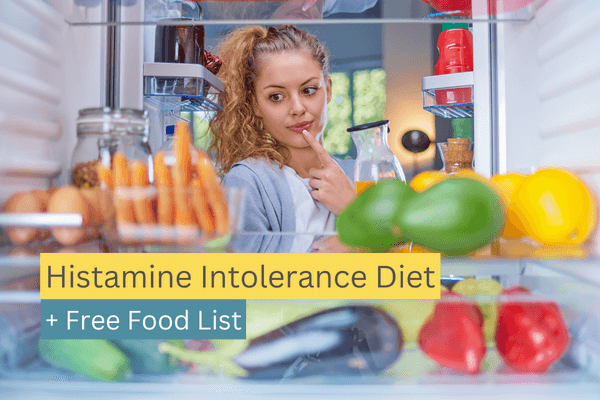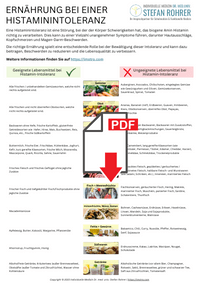
Diet for histamine intolerance
This article focuses on nutrition in the case of histamine intolerance. Find out how you can improve your well-being despite a histamine intolerance by making the right food choices and following proven tips.
Table of contents
Diet for histamine intolerance – introduction and background
Histamine is one of many biogenic amines. It is found in many foods and histamine itself performs important functions as an important messenger substance in the body.
Some people may be hypersensitive to histamine. This is commonly referred to as histamine intolerance. I prefer to use the term histamine depletion disorder, as this is usually the cause of so-called histamine intolerance.
We all have histamine in our bodies, it is an important messenger substance, and if we were intolerant to it, we would not be viable. Histamine depletion disorder or histamine intolerance is defined by exceeding the individual histamine tolerance limit. This is usually caused by a deficiency of the histamine-degrading enzyme diaminooxidase (DAO). A reduction in the activity of the second histamine-degrading enzyme, histamine N-methyltransferase (HNMT), can intensify the symptoms.
In the case of a histamine degradation disorder, the diamine oxidase or diamine oxidase activity, measured in the blood, is usually reduced and the histamine level, measured in the heparin blood, is increased. Elevated histamine levels in heparin blood can of course also have other causes, which is why I always carry out a detailed differential diagnosis using laboratory tests.
Other causes of increased histamine levels are, for example
- Type 1 allergies (IgE-mediated allergies e.g. hay fever, animal hair allergy)
- Pseudoallergies (not IgE-mediated, e.g. reaction to food additives such as glutamate)
- Mast cell activation diseases (MCAD, see also: Disorder of mast cell function)
- Increased histamine production in the intestine due to dysbiosis and transfer of histamine into the bloodstream in the presence of leaky gut (see also: Leaky Gut Syndrome)
I would like to point out here that a reduced intake or avoidance of histamine-rich foods is very important, especially in the case of leaky gut syndrome, as otherwise there is an increased transfer of histamine into the portal blood. If the intestinal barrier is intact, a reduction in histamine-rich foods is usually not absolutely necessary for therapeutic purposes.
Symptoms of histamine intolerance
Elevated histamine levels can lead to a variety of unpleasant symptoms, including skin rashes, digestive problems, dizziness, fatigue, nausea, asthma-like symptoms, swollen nasal mucous membranes, headaches, heart palpitations, drop in blood pressure and more (see Tbl. 1).
It should be noted that it usually takes years before a diagnosis is made and patients have consulted many doctors from different specialties, usually unsuccessfully, as they only ever treat the symptoms in their area. Histamine intolerance is a chameleon.

Diet for histamine intolerance – hints + tips
Avoid foods with a high histamine content
To minimize the symptoms of histamine intolerance, it is important to avoid foods with a high histamine content. These include:
- Mature and fermented foods: for example cheese (especially hard cheese), sauerkraut, soy sauce, vinegar.
- Smoked and cured foods: such as smoked fish, ham, sausage.
- Alcoholic drinks: Especially red wine, beer and champagne.
- Pickled foods: such as pickled olives or pickled vegetables.
- Strongly spiced foods: Hot spices and spice mixtures.
- Foods containing yeast: Like fresh bread and bread rolls.

Be aware of histamine-releasing foods
In addition to foods with a high histamine content, foods that can promote the release of histamine in the body should also be avoided. These include:
- Foods rich in histidine: This is an amino acid that the body can convert into histamine. These include nuts, seeds, shellfish and pulses.
- Foods that inhibit the enzymes that break down histamine: These enzymes are normally responsible for the breakdown of histamine. However, some foods, such as alcohol and black tea, can inhibit the effect of these enzymes.
Suitable foods for histamine intolerance:
Fortunately, there are many foods that are generally better tolerated. Here are some options:
- Fresh meat and fish: Fresh, unprocessed varieties are often better tolerated.
- Fresh fruit and vegetables: Make sure that the food is fresh and not overripe.
- Gluten-free grains: Rice, potatoes, corn and gluten-free grains are good alternatives.
- Herbal teas: Chamomile, peppermint or ginger teas can be a good choice.
Pay attention to processing and storage:
In addition to choosing the right food, processing and storage are also crucial.
Histamine often forms during the storage of food as it matures. It is therefore advisable to prepare and consume food as fresh as possible. Also avoid storing or reheating food for a long time, as this can increase the histamine content.
Keep a food diary:
To identify your individual trigger foods, it can be helpful to keep a food diary. Make a note of which foods you ate and which symptoms occurred afterwards. This can help your doctor to make a customized recommendation for your diet.

Test your histamine breakdown capacity:
The diamine oxidase activity or the diamine oxidase can be quantitatively determined in the blood as well as histamine in heparin blood. There are other parameters here to differentiate more precisely.
Diet for histamine intolerance – free food table to download
You are also welcome to use our free food list for a diet for histamine intolerance. To download, simply click on the image and the list will open in a new window. You can then either print and/or download the food list. (Remark: The list is currently only available in German.)
Further information on this topic can also be found here:
– Mast cell dysfunction
– Mast cell activation syndrome (MCAS)
Food supplements that can be helpful for histamine intolerance
- Vitamin C, preferably retarded, has a mast cell-stabilizing effect (black cumin oil, quercetin and other polyphenols also have a mast cell-stabilizing effect)
- Vitamin B-6, copper, zinc and manganese are essential cofactors for the histamine-degrading enzymes. A deficiency should be clarified and compensated for if necessary.
- SAMe: S-adenosylmethionine is an important coenzyme of HNMT and can help break down intracellular histamine depots. SAMe acts here as a so-called methyl group donor.
Finally, it is important to emphasize that nutrition is only one aspect of treating elevated histamine levels or histamine intolerance. A combination of several therapies is always necessary to achieve success.
Please note that this information only provides an overview of the subject and cannot replace medical advice.
We hope that this information will help you to better understand the importance of nutrition in the case of elevated histamine levels or histamine intolerance.
Your health is close to our hearts.
For further information, please do not hesitate to contact us. Feel free to contact us anytime and arrange an appointment if you have any questions.
Stay healthy and informed!
Dr. Stefan Rohrer


 PDF format (5.38 MB)
PDF format (5.38 MB)